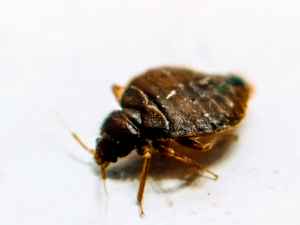Home / Blog / What Are Vole Traps, and How Do You Use Them?
What Are Vole Traps, and How Do You Use Them?

Scientifically reviewed by Rachel Maldonado
-Published on June 10, 2024
-Updated on August 23, 2024
What Are Vole Traps, and How Do You Use Them?
Imagine walking through your garden on a bright, sunny morning, feeling the soft crunch of earth beneath your feet, and admiring the vibrant blooms of your hard work.
Suddenly, you notice patches of dying plants and tiny mounds of soil that weren’t there before. Then it hits you – voles! These small, burrowing rodents can turn your beautiful garden into a disaster zone in no time.
But don’t worry; there’s a way to regain control. Vole traps can be your best ally in this battle. If you’re curious about how they work and how well they work, this post is for you – we’ll walk you through what vole traps are and how you can use them effectively to protect your garden.
Understanding Voles: The Garden Invaders

Before we get into the mechanics of vole traps, you need to understand what you’re dealing with.
Voles, also known as meadow mice or field mice, are small, stocky rodents that primarily feed on plants, including roots, bulbs, and seeds. They belong to the Microtus genus and are often confused with the same mice you see scurrying around your home. However, they tend to have a more compact body, rounded ears, and a shorter tail.
Voles are known for their extensive tunneling activities underground, creating intricate burrow systems that serve as shelter and protection from predators. They reproduce rapidly, with females capable of having multiple litters in a year, contributing to their population growth.
It’s their burrowing habits that are most problematic, as they can cause extensive damage to lawns and gardens, and they can reproduce at an alarming rate, making quick action crucial.
Types of Vole Traps
Vole traps come in various forms, but they all aim to capture or eliminate these pesky critters. Here are the most common types of traps you’ll encounter:
- Snap Traps: These are similar to the classic mouse traps. They’re easy to set and can be very effective.
- Live Traps: These traps capture voles without harming them, allowing you to release them far away from your garden.
- Glue Traps: These are sticky boards that trap voles when they walk across them. However, they are less humane and not always recommended.
- Electronic Traps: These use a small electrical charge to kill the vole instantly. They’re efficient but can be more expensive.
How to Set Up Vole Traps
Setting up vole traps is straightforward, but doing it correctly will significantly increase your chances of success. Here’s a step-by-step guide:
1. Identify Active Areas
First, you need to find where the voles are most active. Look for vole runways, which are narrow, well-worn paths in the grass. You might also see small burrow openings.
2. Choose Your Traps
Based on your comfort level and preference, choose the type of trap you want to use. For beginners, snap traps are a good starting point because they are simple and effective.
3. Bait the Traps
Voles are attracted to peanut butter, apple slices, or oatmeal. Apply a small amount of bait to the trap to lure them in.
4. Set the Traps
Place the traps perpendicular to the vole runways, with the bait end facing the runway. This positioning ensures the vole will encounter the trap while moving along its usual path.
5. Check the Traps
Check your traps daily. If you’ve caught a vole, dispose of it according to local regulations. If you’re using live traps, release the voles in a suitable area far from your home in accordance with local wildlife laws and regulations.
Tips for Effective Vole Trapping
The steps above should help you get started with trapping voles, but to be successful, you’ll want to take a few extra steps. Here are some “bonus” tips:
- Use Multiple Traps: Voles reproduce quickly, so using multiple traps increases your chances of catching more of them.
- Wear Gloves: Always wear gloves when handling traps to avoid leaving your scent on them, which can deter voles.
- Be Persistent: Vole control isn’t a one-and-done task. Regular monitoring and resetting of traps are necessary to keep the population under control.
- Change Bait Regularly: Fresh bait is more attractive to voles. Replace it every few days to maintain effectiveness.
- Combine Methods: For best results, combine trapping with other vole control methods like habitat modification and repellents.
Preventing Future Vole Infestations
Once you’ve managed to reduce the vole population, you need to take steps to prevent future infestations. After all, you probably don’t want to spend the rest of your life trapping and clearing traps! Here are some effective ways to prevent voles from becoming a recurring issue:
- Remove Food Sources: Clear away fallen fruits, vegetables, and other potential food sources from your garden.
- Eliminate Shelter: Trim back overgrown vegetation and remove debris where voles might hide.
- Install Barriers: Use hardware cloth or mesh to protect young trees and plants by wrapping it around the base.
- Maintain Your Lawn: Regular mowing and lawn maintenance can disrupt vole runways and make your yard less attractive to them overall.
Protect Your Garden by Getting Rid of Voles
Dealing with voles can be challenging, but with the right tools and strategies, you can protect your garden and enjoy the fruits (and flowers) of your labor. Vole traps are an effective solution that, when used correctly, can help you manage and control these unwelcome guests.
Are you ready to take the next step in safeguarding your garden? Join our family of satisfied customers at Hawx Pest Control Virginia Beach VA. Our expert team is here to help you tackle any pest problem efficiently and humanely.
We might not be able to help you develop a green thumb, but we can help you get rid of pests that are making it harder for your garden to thrive. Contact us today to learn more about our services and how we can help keep your garden vole-free!
Related Articles
Visit our blog to learn more.
→







